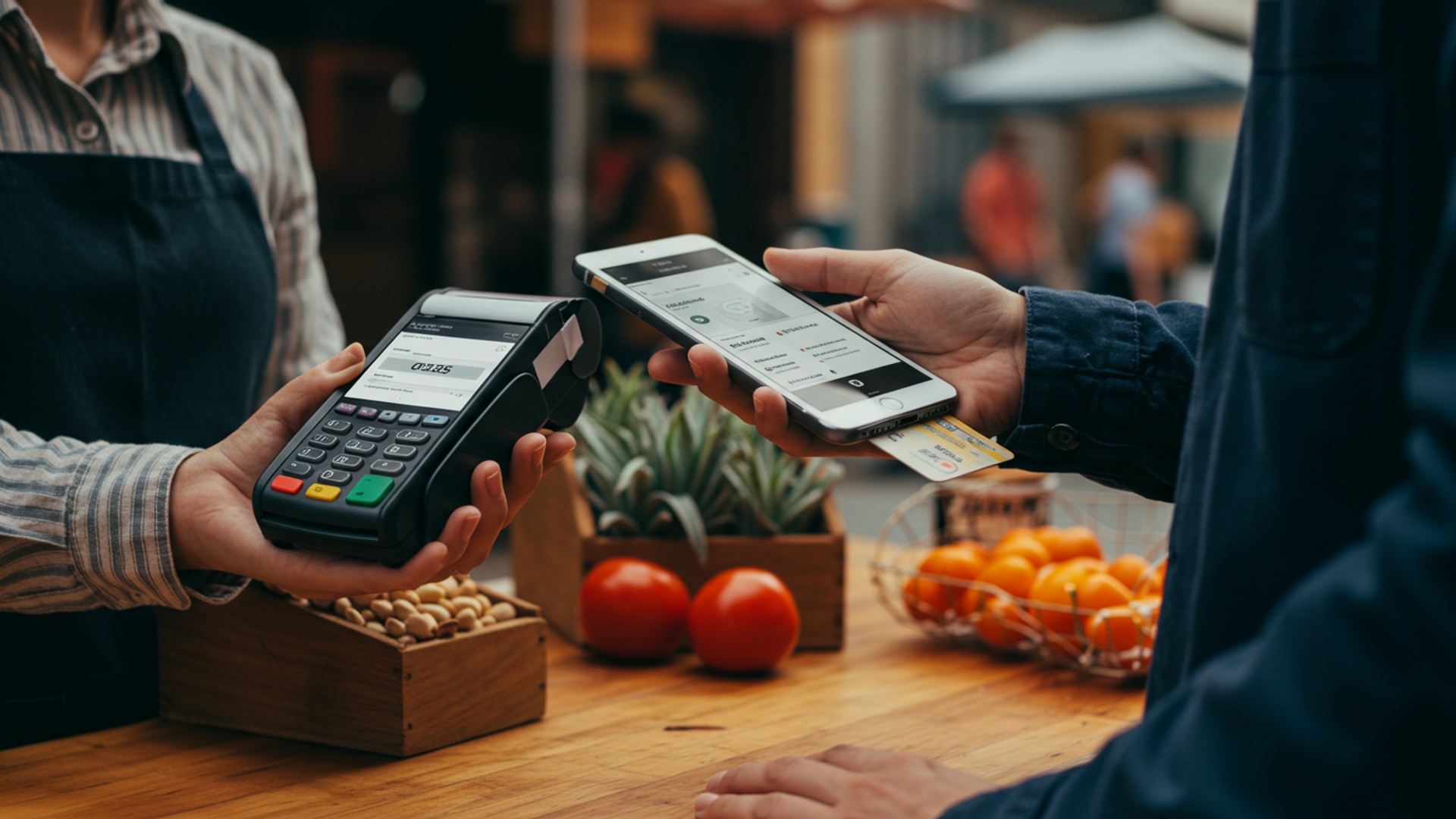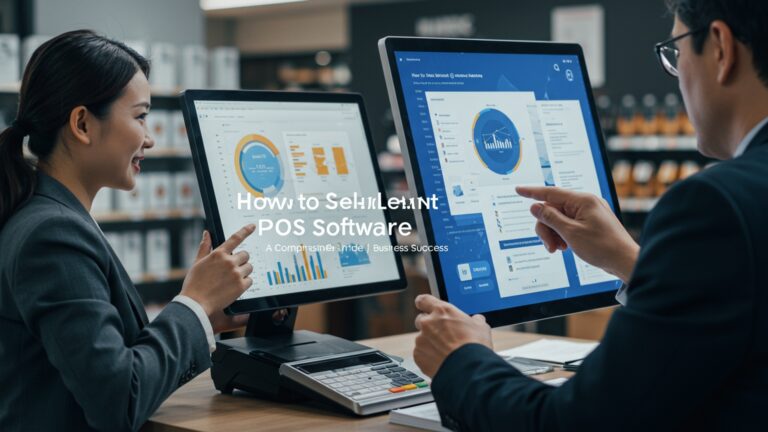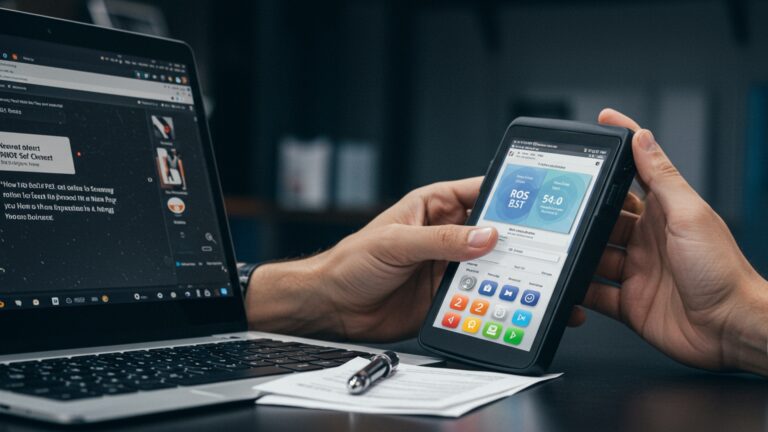Guide to Implementing Mobile POS Software for Flexible Business Transactions
The contemporary business landscape demands unprecedented agility, moving far beyond fixed-counter transactions to embrace dynamic retail environments like pop-up shops, food trucks. field services. Businesses increasingly leverage advanced mobile POS software to meet this evolving need, enabling seamless, secure payments anywhere, anytime. This shift empowers staff to process sales, manage inventory. access customer data directly from a tablet or smartphone, fundamentally transforming operational efficiency and customer engagement. Implementing such a flexible system is no longer a luxury but a strategic imperative, allowing enterprises to adapt to contactless payment trends, optimize inventory management in real-time. deliver superior service across diverse transaction points, ultimately driving growth and enhancing market responsiveness.

Understanding Mobile POS Software: The Foundation of Flexibility
In today’s fast-paced business environment, flexibility and efficiency are paramount. Traditional point-of-sale (POS) systems, with their bulky registers and fixed locations, often hinder these critical aspects. This is where mobile POS software steps in, revolutionizing how businesses conduct transactions and manage operations. At its core, mobile POS software transforms a smartphone, tablet, or dedicated mobile device into a complete sales terminal, allowing transactions to occur anywhere, anytime.
Think of it as your entire checkout counter, inventory manager. customer relationship tool, all neatly packed into a portable device. Unlike its static predecessors, mobile POS software leverages cloud technology, meaning all your sales data, inventory levels. customer data are stored securely online, accessible from any internet-enabled device. This fundamental shift from local data storage to cloud-based solutions is what truly unlocks its power and versatility.
Key components of a robust mobile POS software system typically include:
- Software Application
- Card Reader
- Receipt Printer (Optional)
- Barcode Scanner (Optional)
- Cash Drawer (Optional)
The brain of the operation, installed on a mobile device, facilitating sales, refunds. operational tasks.
A small device that attaches to the mobile device, enabling secure processing of credit and debit card payments (e. g. , swipe, chip, tap/NFC).
Compact, wireless printers for physical receipts, though many systems offer email or SMS receipt options.
Either an integrated camera function within the app or a separate handheld scanner for quick product identification.
A physical component for cash transactions, often connected wirelessly or via Bluetooth.
The transition to mobile POS software is not just about processing payments; it’s about reimagining the entire customer interaction and operational workflow, making it faster, more personal. ultimately, more profitable for businesses of all sizes.
The Benefits of Adopting Mobile POS Software
The adoption of mobile POS software brings a cascade of advantages that can significantly impact a business’s bottom line and customer satisfaction. These benefits extend far beyond simply processing payments on the go.
- Enhanced Customer Experience
- Personalized Service
- Queue Busting
- Flexible Payment Options
- Increased Operational Efficiency
- Streamlined Sales Process
- Anywhere, Anytime Transactions
- Simplified Employee Management
- Improved Data Insights
- Real-time Reporting
- Customer Data Collection
- Scalability and Flexibility
- Grow with Your Business
- Adapt to Change
- Cost-Effectiveness
- Lower Upfront Costs
- Reduced Maintenance
Staff can assist customers on the sales floor, answer product questions with real-time inventory checks. complete purchases without leaving their side. This reduces wait times and creates a more engaging shopping experience. For example, a retail associate can use mobile POS software to check if an item is available in another size or color at a different store location, offering to ship it directly to the customer’s home.
During peak hours, staff can use mobile devices to process transactions directly on the sales floor, drastically shortening lines at traditional checkout counters.
Most mobile POS systems support a wide array of payment methods, including credit/debit cards, mobile wallets (Apple Pay, Google Pay). sometimes even digital invoicing, catering to diverse customer preferences.
Sales can be completed faster, with fewer steps. Integrated inventory management means stock levels are updated instantly after each sale, reducing manual errors and saving time.
Businesses are no longer tethered to a fixed counter. Pop-up shops, food trucks, outdoor events. even table-side service in restaurants become seamless operations.
Many mobile POS software solutions include features for employee clock-in/out, shift management. performance tracking, simplifying HR tasks.
Access to sales data, inventory levels. customer purchasing habits is available instantly. This allows business owners to make informed decisions quickly, such as optimizing product assortments or identifying peak sales periods.
Capture valuable customer details like purchase history and preferences, which can be leveraged for targeted marketing campaigns and loyalty programs.
Mobile POS solutions are highly scalable. As your business expands, adding new terminals or locations is often as simple as downloading the app onto another device and configuring it.
Whether you’re opening a seasonal kiosk or expanding your service offerings, mobile POS software can adapt quickly, without the need for significant hardware investments or complex installations.
Compared to traditional POS systems which often require expensive proprietary hardware and complex installations, mobile POS typically leverages existing smartphones or tablets, significantly reducing initial investment.
Cloud-based updates mean less need for on-site IT support and maintenance, further contributing to cost savings.
As industry expert Sarah Jenkins, CEO of RetailTech Solutions, often states, “Mobile POS software isn’t just a convenience; it’s a strategic tool that empowers businesses to be more agile, customer-centric. data-driven in an increasingly competitive marketplace.”
Key Considerations Before Implementation
Before diving into the implementation of mobile POS software, a thoughtful evaluation of several key factors is crucial. This proactive approach ensures that the chosen solution aligns perfectly with your business needs and long-term goals.
- Hardware Compatibility
- Card Readers
- Receipt Printers
- Barcode Scanners
- Cash Drawers
- Software Features
- Inventory Management
- Customer Relationship Management (CRM)
- Reporting and Analytics
- Employee Management
- Refunds and Returns
- Offline Mode
- Security Measures
- PCI DSS Compliance
- Data Encryption
- Fraud Protection
- User Permissions
- Integration Capabilities
- Accounting Software
- E-commerce Platforms
- CRM Systems
- Loyalty Programs
- Pricing Models and Support
- Subscription Fees
- Transaction Fees
- Hardware Costs
- Customer Support
- Updates and Maintenance
While the beauty of mobile POS lies in leveraging existing devices, ensure your current or planned hardware (smartphones, tablets) meets the software’s minimum requirements. Beyond the main device, consider peripherals:
Are they EMV chip and NFC (tap-to-pay) compliant? Do they connect via Bluetooth, headphone jack, or USB-C?
Will you need thermal printers for physical receipts. are they compatible (Bluetooth or Wi-Fi)?
Can the software use your device’s camera as a scanner, or will you need a separate Bluetooth scanner for high-volume scanning?
If cash transactions are frequent, ensure the system can trigger a compatible cash drawer.
The core functionality of the mobile POS software must cater to your specific operational needs. Look beyond basic transaction processing:
Does it offer real-time tracking, low-stock alerts. multi-location inventory?
Can it store customer profiles, purchase history. facilitate loyalty programs?
What kind of sales reports, employee performance data. product insights does it provide? Is it customizable?
Features like time tracking, shift scheduling. permission levels for different staff roles.
How easily can these be processed and tracked?
Can the system continue to process sales even without an internet connection, syncing data once connectivity is restored? This is vital for reliability.
Protecting sensitive customer and business data is paramount. Any mobile POS software you choose must adhere to industry best practices:
Ensure the system is Payment Card Industry Data Security Standard (PCI DSS) compliant to securely handle cardholder data.
All transaction data, both in transit and at rest, should be encrypted.
Look for features that help detect and prevent fraudulent transactions.
Granular control over what each employee can access and modify within the system.
Your POS system rarely operates in a vacuum. Seamless integration with other business tools is key to a unified operation:
Integration with platforms like QuickBooks, Xero, or Sage can automate bookkeeping and reduce manual data entry.
If you have an online store (e. g. , Shopify, WooCommerce), ensure the mobile POS can sync inventory and sales data between your physical and online channels.
Deeper integration for comprehensive customer insights and marketing automation.
Ability to integrate with or manage your customer loyalty initiatives.
interpret the total cost of ownership, not just the monthly subscription fee:
Are they per device, per user, or based on transaction volume?
What are the processing rates for credit/debit cards? Are there any hidden fees?
Are peripherals sold separately, or are there bundles?
What kind of support is offered (24/7, phone, email, chat)? Is there a knowledge base or community forum?
How often is the software updated. are these updates included in the subscription?
A Step-by-Step Guide to Implementing Mobile POS Software
Implementing mobile POS software can seem daunting. by following a structured approach, businesses can ensure a smooth transition and maximize the benefits. This guide breaks down the process into actionable steps.
Step 1: Needs Assessment and Vendor Selection
The first and most critical step is to clearly define what your business needs from a mobile POS system. This involves a thorough internal review.
- Define Your Requirements
- What types of transactions do you process (cash, card, mobile payment)?
- Do you need robust inventory management, employee tracking, or customer loyalty features?
- What is your average transaction volume?
- Do you operate in a single location, multiple stores, or a mobile environment (food truck, pop-up)?
- What is your budget for monthly subscriptions and hardware?
- Research and Compare Vendors
Once you have a clear understanding of your needs, research different mobile POS software providers. Look at their features, pricing, customer reviews. support. A comparative table can be incredibly useful here:
| Feature/Vendor | Vendor A (e. g. , Square POS) | Vendor B (e. g. , Shopify POS) | Vendor C (e. g. , Lightspeed Retail) |
|---|---|---|---|
| Target Business Size | Small to Medium | Small to Large (e-commerce focus) | Medium to Large Retail/Restaurant |
| Key Features | Payment processing, basic inventory, reporting, CRM | Omnichannel sales, inventory sync, staff management | Advanced inventory, multi-location, analytics, restaurant features |
| Hardware Needs | Minimal (smartphone/tablet + reader) | Tablet-based, various peripherals | Tablet/PC based, extensive peripherals |
| Offline Mode | Yes (limited functionality) | Yes | Yes |
| Integration | Limited native, API available | Extensive app store | Strong third-party integrations |
| Pricing Model | Transaction fees, optional monthly for advanced features | Monthly subscription + transaction fees | Monthly subscription + transaction fees |
Consider requesting demos or free trials to get hands-on experience with the interfaces and functionalities. Speak to other business owners using these systems for candid feedback.
Step 2: Hardware Acquisition and Setup
Once you’ve selected your mobile POS software, it’s time to gather and configure the necessary hardware.
- Acquire Devices
- Select Peripherals
- Initial Setup
- Charge all devices and peripherals.
- Install the mobile POS software application on your primary mobile devices.
- Pair Bluetooth peripherals (card readers, printers) with your mobile devices.
- Ensure a stable internet connection (Wi-Fi or mobile data) is available at all points of sale.
Purchase or utilize existing smartphones or tablets that meet the software’s specifications.
Order compatible card readers, receipt printers, barcode scanners. cash drawers. Ensure they are certified for use with your chosen mobile POS software.
Step 3: Software Configuration and Data Migration
This step involves populating your mobile POS software with your business-specific details.
- Account Creation and Settings
- Product/Service Catalog
- Input all your products or services, including names, descriptions, prices, SKUs. categories.
- Upload product images if the system supports it.
- Configure inventory levels for each item. Most systems allow bulk imports via CSV files, which can save significant time.
- Employee Profiles
- Payment Methods
- Customizations
Set up your business account, configure tax rates, currency. other general settings.
Create user accounts for each staff member, assigning appropriate roles and permissions.
Configure accepted payment types, including connecting your payment processing gateway for card transactions.
Personalize receipts, set up loyalty programs, or configure any specific workflows your business requires.
For example, if you’re migrating from an older system, you might export your product data into a CSV format and then import it into your new mobile POS software. A typical CSV structure for product data might look like this:
"SKU","Product Name","Description","Price","Category","Current Stock"
"P001","Organic Coffee Beans","Premium Arabica, 12oz","14. 99","Beverages","150"
"P002","Stainless Steel Water Bottle","Eco-friendly, 24oz","19. 95","Accessories","80"
Step 4: Staff Training
Your team is on the front lines, so comprehensive training is essential for successful adoption.
- Hands-on Sessions
- Scenarios and Troubleshooting
- Resource Availability
- Feedback Loop
Conduct practical training sessions where employees can simulate transactions, process refunds. practice using all features of the mobile POS software.
Present common scenarios (e. g. , customer asks for a gift receipt, a card declines) and guide staff on how to handle them using the system.
Provide a quick-reference guide or FAQs. Ensure staff know where to find help (e. g. , internal supervisor, software vendor’s support).
Encourage staff to provide feedback on their experience, which can help identify areas for further training or system adjustments.
Step 5: Go-Live and Post-Implementation Support
The day you start using your new mobile POS software is just the beginning.
- Pilot Phase (Optional but Recommended)
- Monitor Performance
- Gather Feedback
- Ongoing Support
For larger businesses, consider a phased rollout or a pilot phase in a less busy period to iron out any kinks before a full launch.
Closely monitor transactions, inventory updates. overall system performance during the initial days and weeks.
Continue to solicit feedback from both staff and customers. What’s working well? What could be improved?
Maintain open communication with your mobile POS software vendor’s support team for any technical issues or questions that arise. Regularly review reports and adjust your strategy based on the data.
Real-World Applications and Success Stories
The versatility of mobile POS software means it’s not confined to a single industry. Its flexible nature makes it an ideal solution for a diverse range of businesses, enabling them to operate more efficiently and reach customers wherever they are.
- Retail
- Pop-Up Shops and Market Stalls
- Queue Busting in Brick-and-Mortar Stores
- Personalized Shopping Assistance
- Restaurants and Food Service
- Table-Side Ordering and Payment
- Food Trucks and Cafes
- Event Catering
- Service Businesses
- Field Services (Plumbers, Electricians)
- Salons and Spas
- Photography and Event Planning
Small businesses, artisans. craft vendors can set up temporary retail spaces with ease. A local artisan selling handmade jewelry at a weekend market can simply use a tablet with mobile POS software and a portable card reader to accept payments, track inventory. email receipts, all without the need for a bulky cash register or a dedicated power outlet.
During holiday rushes or busy sales events, large retailers deploy associates with mobile devices to process transactions directly on the sales floor, dramatically reducing checkout lines and improving customer flow. This was a game-changer for a major electronics retailer during Black Friday, where they reported a 20% reduction in average customer wait times after implementing mobile POS software for floor associates.
Sales associates can use tablets to check product availability in other sizes or colors, show customer reviews, or even process an entire order for an item not currently in stock, having it shipped directly to the customer’s home.
Fine dining establishments and casual eateries alike use mobile POS to take orders and process payments directly at the table, improving order accuracy, speeding up service. allowing servers to turn tables faster. “We saw our average table turnover time decrease by 15% and our tip averages increase once our servers started using mobile POS devices,” recounts Maria Rodriguez, owner of “The Urban Bistro.”
These mobile businesses are natural fits for mobile POS software. A popular food truck can easily manage a high volume of orders and payments on the go, tracking ingredients and sales in real-time.
Caterers can process payments and manage orders at various event locations without needing to transport heavy, complex equipment.
Technicians can invoice clients and accept payments on-site after completing a service call, streamlining the billing process and improving cash flow.
Stylists and therapists can manage appointments, process payments. rebook clients directly from their workstations, offering a seamless client experience.
Professionals can accept deposits and final payments from clients at consultations or during events, maintaining a professional image.
Case Study: “Boutique Blooms” Florist
Boutique Blooms, a small, independent florist, struggled with their traditional POS system, especially during peak seasons like Valentine’s Day and Mother’s Day. Their single fixed terminal created long lines. they couldn’t easily handle sales at local farmers’ markets or deliver flowers and accept payment on delivery. Implementing a leading mobile POS software provider transformed their operations.
- They equipped their delivery drivers with smartphones running the POS app and portable card readers, allowing them to accept payments at the customer’s doorstep.
- During busy periods, staff members used tablets on the sales floor to assist customers, look up specific flower types. process orders, effectively “busting” queues at the main counter.
- Their inventory management became real-time, reducing waste and ensuring popular flowers were always in stock.
Within six months, Boutique Blooms reported a 25% increase in seasonal sales due to improved efficiency and customer service, along with a significant reduction in order errors. The owner, David Chen, noted, “The mobile POS software allowed us to be where our customers are, whether in the shop, at a market, or at their homes. It truly brought flexibility to our business.”
Overcoming Common Challenges
While mobile POS software offers immense benefits, businesses may encounter certain challenges during and after implementation. Being aware of these potential hurdles and having strategies to address them can ensure a smoother, more successful adoption.
- Connectivity Issues
- Solution
- Data Security Concerns
- Solution
- Employee Adoption and Training
- Solution
- Hardware Maintenance and Malfunctions
- Solution
- Integration Complexity
- Solution
Dependence on a stable internet connection is a primary concern for any cloud-based system. Intermittent Wi-Fi or poor mobile data reception can disrupt transactions.
Prioritize mobile POS software with robust offline capabilities. This allows transactions to be processed even without an internet connection, with data syncing automatically once connectivity is restored. Always have a backup internet source, such as a mobile hotspot, for critical sales periods. For fixed locations, ensure a strong, reliable Wi-Fi network.
Handling sensitive customer payment details on mobile devices raises valid security questions, especially with the increasing threat of cyberattacks.
Choose PCI DSS compliant mobile POS software providers that employ end-to-end encryption for all transaction data. Implement strong password policies, multi-factor authentication for staff accounts. regularly update software to patch any vulnerabilities. Educate staff on best practices for data handling and device security. Consider using dedicated devices for POS rather than personal phones.
Resistance to new technology or insufficient training can lead to errors, slow service. frustration among staff.
Involve employees in the selection process where possible to foster a sense of ownership. Provide thorough, hands-on training sessions that cover all common scenarios. Offer ongoing support and create easy-to-access reference materials. Highlight the benefits of the new mobile POS software to employees, such as reduced manual work and improved efficiency, to encourage buy-in.
Mobile devices and peripherals are prone to drops, battery issues, or other technical malfunctions, which can halt operations.
Invest in durable, protective cases for mobile devices. Have backup hardware (e. g. , an extra card reader or fully charged tablet) readily available, especially during peak hours. Regularly check battery levels and ensure devices are charged. Establish a clear process for reporting and replacing faulty equipment.
Integrating mobile POS software with existing accounting, inventory, or e-commerce systems can sometimes be complex, leading to data inconsistencies or workflow disruptions.
Carefully vet the integration capabilities of your chosen mobile POS software during the selection phase. Opt for vendors that offer robust, well-documented APIs or native integrations with your existing business tools. Plan the integration process meticulously, possibly with the help of IT professionals. conduct thorough testing before going live to ensure data flows smoothly and accurately between systems.
The Future of Mobile POS Software
The landscape of retail and transactions is in constant evolution. mobile POS software is at the forefront of this transformation. Looking ahead, several emerging trends and technological advancements are poised to redefine its capabilities and impact on businesses.
- AI and Machine Learning Integration
- Predictive Analytics
- Personalized Customer Recommendations
- Fraud Detection
- Enhanced Contactless Payments and Biometrics
- Augmented Reality (AR) for Product Visualization
- Deeper Omnichannel Integration
- Voice Commerce and Conversational Interfaces
- Hyper-Personalization and Loyalty
Artificial intelligence (AI) and machine learning (ML) are set to make mobile POS software even smarter. Expect to see:
AI will review sales data to forecast demand more accurately, helping businesses optimize inventory and staffing. Imagine your POS system suggesting which items to restock based on historical sales and upcoming events.
Leveraging customer purchase history, AI can suggest personalized product recommendations to customers directly on the mobile device, enhancing upselling and cross-selling opportunities for staff.
ML algorithms can identify unusual transaction patterns in real-time, significantly improving fraud prevention.
The shift towards contactless payments (NFC, QR codes) will continue to accelerate, driven by convenience and hygiene concerns. Mobile POS software will seamlessly integrate with an even wider array of these payment methods. Moreover, biometric authentication (fingerprint, facial recognition) is likely to become more common for secure transaction authorization and employee login, offering enhanced security and speed.
Imagine a sales associate using a tablet with AR capabilities to show a customer how a piece of furniture would look in their home, or how a garment would fit, all through the mobile POS software interface. This immersive shopping experience can drive engagement and sales, blurring the lines between physical and digital retail.
The distinction between online and in-store shopping will continue to fade. Future mobile POS software will offer even more seamless integration with e-commerce platforms, social media selling. supply chain management. This means unified inventory across all channels, consistent customer data. the ability to manage online orders, in-store pickups. returns all from a single mobile device.
As voice assistants become more sophisticated, integrating voice commands into mobile POS software could streamline operations further. Staff might be able to process orders, check stock, or retrieve customer data using voice commands, enhancing efficiency and hands-free operation.
Future iterations of mobile POS software will likely offer more advanced tools for hyper-personalizing customer interactions. This includes real-time loyalty point updates, personalized discounts triggered at the point of sale based on purchase history. seamless integration with customer relationship management (CRM) systems to provide a truly tailored experience.
As technology continues to advance, mobile POS software will evolve from a simple transaction tool into a powerful, intelligent. indispensable business management platform, offering unprecedented flexibility and insights to businesses of all scales.
Conclusion
Implementing mobile POS isn’t merely adopting new tech; it’s embracing unparalleled operational flexibility. Remember, the true power lies in empowering your team to transact anywhere, transforming customer interactions whether you’re at a bustling farmers’ market or managing curbside pickups. My personal advice: start by identifying your most constrained transaction points. For instance, I once helped a local coffee cart streamline their morning rush, instantly cutting wait times by switching to a mobile POS that supported tap-to-pay and QR code orders – a clear win in today’s fast-paced, contactless-preferring environment. This strategic shift allows you to move beyond static counters, adapting to the dynamic demands of modern consumers. Focus on seamless integration with existing inventory and CRM systems, ensuring data flows effortlessly. Embrace mobile POS not as an expense. as an investment in agility and customer satisfaction, propelling your business towards a future of limitless transactional possibilities.
More Articles
Unlock Sales Power How to Use Mobile POS Software on the Go
Master Android POS Software How to Transform Your Mobile Device into a Sales Hub
How to Choose the Best Cloud Based POS Software for Your Growing Business
Your Ultimate Guide How to Select the Right POS Software for Small Businesses
Learn How to Streamline Billing and POS Software for Seamless Business Operations
FAQs
What exactly is mobile POS software?
It’s essentially a point-of-sale system that runs on mobile devices like smartphones or tablets. Instead of being tied to a counter with a bulky cash register, you can process sales, accept payments. manage inventory from anywhere within your business premises, or even on the go.
Why should my business even bother with mobile POS?
The biggest perks are flexibility and efficiency. You can serve customers directly on the sales floor, reduce checkout lines. even take your business to pop-up events or outdoor markets. It streamlines transactions, improves customer experience. often provides real-time sales data at your fingertips.
Is implementing mobile POS complicated?
Not usually, especially with modern solutions. Many mobile POS systems are designed for user-friendliness. The main steps involve choosing the right software, potentially getting some basic hardware like a card reader, setting up your product catalog. training your team. A good guide can simplify this process significantly.
What types of businesses benefit most from this setup?
Almost any business looking for more flexibility! Retailers, restaurants (especially those with outdoor seating or food trucks), service providers, pop-up shops, event vendors. even small businesses doing home services can all see huge advantages. If you need to process transactions away from a fixed counter, mobile POS is for you.
Do I need special equipment for mobile POS?
You’ll typically need a smartphone or tablet (which you might already have!) , a compatible card reader (often Bluetooth-enabled). sometimes a portable receipt printer. Many systems can also integrate with existing barcode scanners or cash drawers if needed. the core setup is usually quite minimal.
How does mobile POS make transactions ‘flexible’?
It frees you from the traditional checkout counter. You can process sales anywhere – right next to a customer trying on clothes, at their table in a restaurant, or at an outdoor market stall. This means faster service, shorter lines. the ability to accept various payment methods on the spot, enhancing the overall customer experience.
Are there any security worries with mobile transactions?
Security is a top priority for reputable mobile POS providers. They typically use strong encryption for all transactions, comply with PCI DSS standards (Payment Card Industry Data Security Standard). often include features like EMV chip card readers to protect sensitive customer data. It’s crucial to choose a trusted provider with robust security measures.






